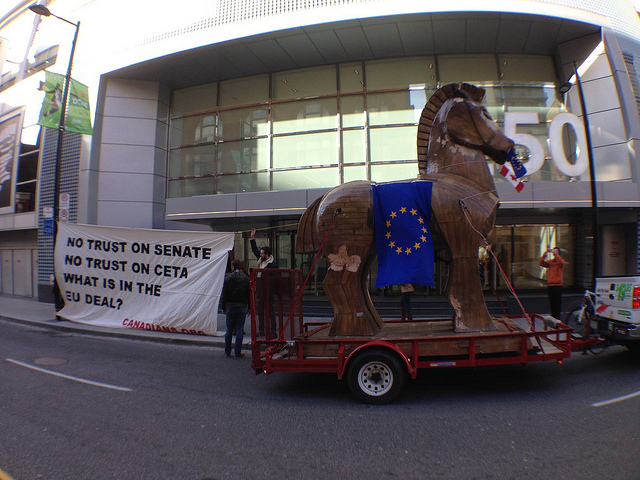The prospect of freer trade with European nations is generally popular among Canadians. And why shouldn’t it be? Doesn’t the Canadian left repeatedly point to the advantages of many European social and economic institutions? Who could argue with lower prices for European cheese, wine, or chocolate?
After all, we’ve been waiting for years for the Canadian economy to pivot to export-led growth, and how can we do that without free trade deals. This is the government’s line. (Even though classical economic theory would say that trade deals are meant to benefit consumers, not exporters).
Well, there are a number of reasons to be concerned about the Canadian-European Comprehensive Economic Trade Agreement (CETA). The first one is that it isn’t just a trade deal. Sure, it eliminates the already low non-agricultural tariffs between Canada and the EU.
And if it stopped there we wouldn’t be having this conversation.
But when advocates think a major selling point of the agreement is that: “It’s not just a trade agreement. It reaches into other regulatory areas and areas of social and economic policy,” we’re going to want to have a chat with some policy-makers.
The CCPA has gathered analysis of CETA’s leaked text from a wide range of experts, to help make sense of the CETA. I’ve summarized some of the key issues below.
Investor-state dispute resolution
The most problematic element is the level of protections that investors receive under the CETA. These investor protections effectively constrain the ability of governments at all levels to introduce new regulations or new public services. Scott Vrooman, a comic who also happens to be a trained economist, humorously summarizes the problems with Investor State Dispute Mechanisms nicely in video and written formats, suggesting that countries are second-class citizens under modern international trade agreements.
Under CETA an international body bypasses national courts, and can make decisions that apply retroactive financial penalties to governments. Compare this to the labour and environment chapter, which allows for a transparent but completely unenforceable dispute resolution process. This process is little more than high-level peer pressure, which we know to be a super effective tactic with our current Conservative government.
Food security
One of the wins for Canada under CETA is increases in the quota of pork and beef that Canadian producers can sell into Europe. There remains considerable doubt about the ability of Canadian beef producers, in particular, to make use of the higher quotas. Canada is not able to fill our current quota of hormone-free beef to the EU, let alone be in a position to take advantage of expanded quotas.
On the other hand, rules around procurement may threaten the increasingly popular “eat local” programs in many municipalities, schools, hospitals, and prisons. Local procurement of food is considered to be an important driver of local food security, as well as a key regional development policy, and part of reducing Canada’s carbon footprint. The threshold for “sub-central” entities is $330,000 CDN, much lower than current restrictions under NAFTA.
Indigenous rights
Since Canada has pledged to endorse the UN Declaration on the Rights of Indigenous Peoples (UNDRIP), the federal government must consult with Indigenous peoples. There is no question that an agreement as all-encompassing as CETA requires the government to receive free, prior, and informed consent from Indigenous peoples whenever Indigenous rights may be affected. The level of secrecy around the process in negotiating CETA makes it very difficult to determine if any effort has been made by the federal government to even consider their responsibilities to Indigenous peoples.
Maritime services
Trade agreements are notoriously dense and difficult to parse, even when one has access to the official text and supporting documents. Maritime services is one example of a “surprise” found in the leaked final text of CETA.
During CETA negotiations, maritime industry players were assured that “cabotage” would be left untouched by the agreement. Cabotage is a technical term that means “the movement of goods or passengers between two ports or places within a single state.” Effectively, ships carrying goods between two Canadian ports must be registered in Canada and adhere to Canadian labour and safety standards. CETA starts to dismantle this, in allowing European shipping from Halifax to Montreal.
As the official text of CETA is released there will certainly be more surprises.
Public services
Trade deals are about tariffs, right? The benefits are lower prices and better choices for consumers. If that is true, then why would a free trade agreement handcuff future governments in their ability to introduce new public services?
The CETA is negotiated under a “positive” list rule, which means that any exclusions must be specifically listed. If you forget to list something, or something “new” is created, then it automatically comes under the full weight of CETA. The “positiv” list method is new to Europeans, and touted as “modern” by Canadian and American trade negotiators.
This means that if a future federal government wants to introduce a public pharmacare or child-care program, they may face investor challenges under CETA. Or worse, future governments may abandon the idea of useful regulations and new public services altogether, because it will simply be too difficult.
This is what the CETA is meant to do — tie the hands of future governments to implement the will of the people. That’s not what a trade agreement is should be allowed to do. No one is afraid of trade. We’re afraid of corporate rights superseding democracy.
Photo: Council of Canadians/flickr



